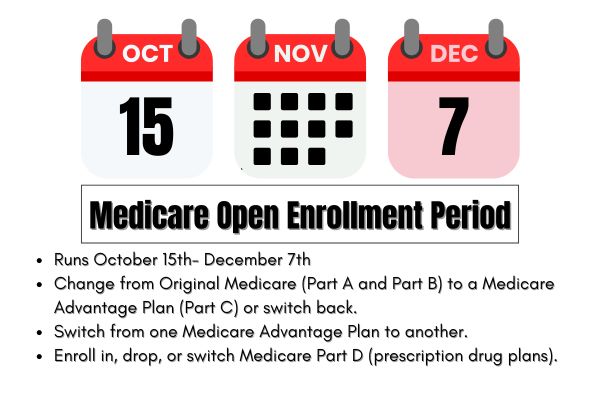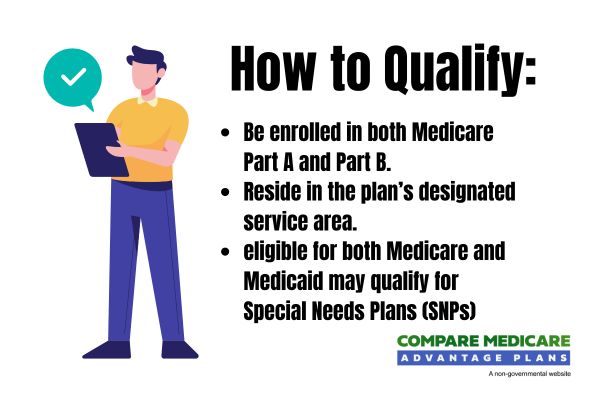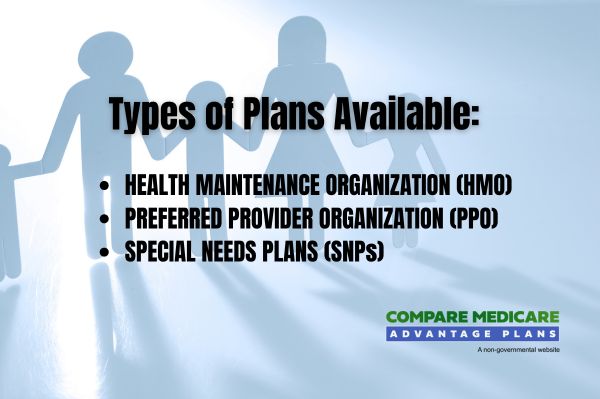




Medicare Advantage Plans Arizona 2026
If you’re planning to enroll in Medicare Advantage Plans in Arizona for 2026, this article is for you. This article will cover the available plan types, potential benefits, and possible costs to help you decide your best option.
Key Takeaways
- Medicare Advantage plans in Arizona will likely provide comprehensive coverage options that may go beyond Original Medicare, which might include additional benefits like dental, hearing, and vision care that could cater to the needs of diverse populations.
- There are different types of Medicare Advantage plans available, including HMO, PPO, and SNPs, each offering unique benefits and requirements to accommodate various healthcare preferences and needs.
- Enrollment for Arizona Medicare Advantage plans occurs annually from October 15 to December 7, with options available for beneficiaries to switch plans based on specific life events throughout the year.
Compare Plans in One Step!
Enter Zip Code
Understanding Arizona Medicare Advantage Plans 2026

Medicare Advantage plans in Arizona could potentially offer an alternative to Original Medicare, with some plans potentially offering additional coverage options and benefits. These plans typically include hospital services, outpatient care, and sometimes additional perks like vision, hearing, and dental care. The potential appeal of integrated care with comprehensive benefits has likely led to increasing enrollment among Arizona’s Medicare beneficiaries.
Arizona’s Medicare Advantage potential offerings will likely cater to a diverse demographic, reflecting member’s varied healthcare needs. From urban centers to rural areas, these plans will likely be designed to meet the unique healthcare requirements of different communities. While all plans must adhere to federal regulations, some might vary significantly in terms of cost-sharing, provider networks, and potential benefits.
Arizona’s Medicare Advantage plans have become a popular choice in recent years. Understanding the different types of plans available and how they could cater to specific healthcare needs is vital.
Types of Arizona Medicare Advantage Plans Available
When it comes to available Medicare Advantage plans in Arizona, there will likely be several types to choose from, each designed to meet different healthcare needs and preferences. Understanding these various options could help you select the plan that best fits your lifestyle and medical requirements.
The primary types of plans include Health Maintenance Organization (HMO) Plans, Preferred Provider Organization (PPO) Plans, and Special Needs Plans (SNPs). Each of these plans offers unique benefits and limitations, which will be explored in the following sections.
HMO Plans
Health Maintenance Organization (HMO) Plans have been a popular choice among Medicare beneficiaries in Arizona in recent years. These plans typically require members to choose a primary care physician (PCP) and get referrals for specialist visits, which helps coordinate care and potentially manage healthcare costs more effectively.
One of the potential advantages of HMO Plans could be the lower premiums and co-pays compared to other plan types. However, these plans require members to use a network of doctors and hospitals, which might limit flexibility if you prefer seeing out-of-network providers.
PPO Plans
Preferred Provider Organization (PPO) Plans offer more flexibility compared to HMOs. Members can see any doctor or specialist without needing a referral, and will likely have the option to see out-of-network providers, though it might come at a higher cost.
PPO Plans could be ideal for those who want more freedom in choosing their healthcare providers. While these plans might come with higher premiums and co-pays than HMOs, the flexibility and broader network of providers will likely be worth the additional cost for many beneficiaries.
Special Needs Plans (SNPs)
Special Needs Plans (SNPs) are tailored for specific groups of people, including those with chronic conditions, individuals living in institutions, and dual-eligible beneficiaries who qualify for both Medicare and Medicaid. There are three types of SNPs: Dual Eligible SNPs (D-SNPs) for those with Medicare and Medicaid, Chronic Condition SNPs (C-SNPs) for those with specific chronic conditions, and Institutional SNPs (I-SNPs) for individuals in institutions.
SNPs must operate under contracts that meet state and federal requirements to ensure appropriate delivery of services for their specific populations. These plans might either be structured as HMOs or PPOs, depending on the provider offering the plan.
Overview of Arizona Medicare Advantage Plans 2026
Certain Arizona Medicare Advantage plans might provide beneficiaries with additional coverage that may go beyond Original Medicare, such as dental, vision, and hearing coverage. These plans will likely include a network of providers, which could potentially impact the cost and accessibility of care for enrollees.
The state of Arizona has seen a significant increase in the enrollment of beneficiaries in Medicare Advantage plans over recent years. Plan availability and benefits may vary widely in Arizona, as different insurance companies could offer various options tailored to local needs. Whether you’re looking for comprehensive healthcare coverage or an affordable plan, there’s likely an Arizona Medicare Advantage plan that meets your needs.
Covered Services and Potential Benefits

Some Medicare Advantage plans in Arizona might offer additional benefits, which may include:
- Preventive, basic, and restorative dental services
- Routine vision exams, along with coverage for glasses or contact lenses
- Hearing services such as routine exams and hearing aids
This potential range of covered services and benefits could make Medicare Advantage plans an attractive option for many beneficiaries in Arizona.
Possible Benefits of Arizona Medicare Advantage Plans
Certain Arizona Medicare Advantage plans could potentially offer reduced premiums, likely making healthcare more affordable. Additionally, some plans may also include comprehensive dental coverage, which could potentially amount to significant savings on various services.
Certain plans may also provide additional benefits such as vision and hearing exams, which are not included in Original Medicare. Another potential advantage might be the easier access to specialists without requiring referrals, which could be a significant benefit for those with complex health conditions. These potential benefits will likely make Medicare Advantage plans a compelling choice for many Arizona residents.
Enrollment Process for Arizona Medicare Advantage Plans 2026
Understanding the enrollment process for Arizona Medicare Advantage plans is crucial to securing the best coverage. Enrollment typically begins on October 15 each year and runs through December 7, known as the Annual Enrollment Period (AEP). Special Enrollment Periods (SEPs) allow individuals to enroll outside the standard dates if specific circumstances occur.
The Initial Enrollment Period (IEP) starts three months before and ends three months after the individual becomes eligible for Medicare. The Medicare Advantage Open Enrollment Period, running from January 1 to March 31, allows those already enrolled in a plan to switch plans or revert to Original Medicare.
These different enrollment periods ensure that beneficiaries have multiple opportunities throughout the year to choose the best plan for their needs.
When to Enroll
The Annual Enrollment Period (AEP) for Medicare Advantage plans starts on October 15 and ends on December 7 each year. Coverage selected during this period typically starts on January 1 of the following year. This period is a critical time for beneficiaries to review their current plans and make any necessary changes.

Special Enrollment Periods (SEPs) provide opportunities to enroll outside of the AEP due to specific circumstances, such as moving to a new area or losing other health coverage. If a plan is being discontinued, affected members have an SEP to enroll in a new plan.
You can enroll in a plan by using this website or by calling one of our licensed agents at 1-833-641-4938 (TTY 711), Mon-Fri 8 am-9 pm EST.
Different Enrollment Periods
The Initial Enrollment Period (IEP) for Medicare Advantage starts three months before and ends three months after the individual becomes eligible for Medicare. This period is the first opportunity for new beneficiaries to enroll in a Medicare Advantage plan. Open Enrollment (AEP) occurs annually from October 15 to December 7, allowing beneficiaries to switch plans or adjust coverage.
The Medicare Advantage Open Enrollment Period (OEP), from January 1 to March 31, is for individuals already enrolled in a Medicare Advantage plan to switch plans or revert to Original Medicare. Special Enrollment Periods (SEPs) are triggered by specific life events, allowing beneficiaries to enroll or change plans outside of standard enrollment times.
OEP, AEP, Special Enrollment
The Open Enrollment Period (OEP) for Medicare Advantage plans runs from October 15 to December 7 each year. The Medicare Advantage Open Enrollment Period (OEP), from January 1 to March 31, allows those already enrolled in a plan to switch plans or revert to Original Medicare.
Special Enrollment Periods (SEPs) provide additional opportunities to enroll due to specific circumstances, such as moving or losing other health coverage.
Potential Costs Associated with Arizona Medicare Advantage Plans 2026

The potential costs associated with Arizona Medicare Advantage plans may vary significantly based on the plan type and coverage options. Some plans may incorporate both premiums and co-pays into their cost structures, possibly affecting overall expenses. Understanding these costs is crucial for budgeting and making an informed decision.
Premiums and Co-Pays
Premiums for Arizona Medicare Advantage plans may vary significantly, as some higher premiums might provide additional benefits. Co-pays for certain services under Medicare Advantage may also differ widely.
Out-of-Pocket Maximums
Certain Arizona Medicare Advantage plans may also include a maximum out-of-pocket limit, which could potentially provide a financial safety net. Once the out-of-pocket maximum has been reached in a plan year, beneficiaries likely won’t pay additional costs for covered services. This potential cap could help ensure that healthcare expenses could remain predictable and manageable.
Covered Services and Potential Benefits
Some Medicare Advantage plans in Arizona may offer comprehensive dental coverage, which might include services like dentures and bridges. Routine services such as vision exams and hearing tests may also be included, sometimes with financial allowances for vision care products like glasses or contact lenses.
Emergency and urgent care services are typically covered under most Medicare Advantage plans, ensuring members have access to necessary care when traveling. These potential benefits could make Medicare Advantage plans a comprehensive and attractive option for many beneficiaries in Arizona.
How to Qualify for Arizona Medicare Advantage Plans 2026

To qualify for Arizona Medicare Advantage plans, individuals must meet the following criteria:
- Be enrolled in both Medicare Part A and Part B.
- Reside in the plan’s service area.
- Meet any specific eligibility requirements related to health status, particularly for Special Needs Plans (SNPs).
It’s important to review the specific plan details and eligibility criteria for each Medicare Advantage plan you’re considering. This will ensure that you meet all the necessary requirements and can take full advantage of the benefits offered.
Contracted Network and Access to Care
Medicare Advantage plans are required to provide enrollees with a clear and accessible provider directory, ensuring individuals can easily find in-network providers. Members can use the Plan Finder Tool on this website to:
- Compare different Medicare Advantage and Prescription Drug Plans
- Focus on drug coverage and costs to find the perfect fit for your healthcare needs
- Input your information and sort through a variety of plans
- Weigh the pros and cons of each based on your personal situation.
Comparing Arizona Medicare Advantage Plans to Original Medicare
Some Arizona Medicare Advantage Plans may provide additional benefits that Original Medicare does not cover, such as dental, hearing, and vision services. Understanding the various differences in coverage and costs between these options could help you make an informed decision.
Coverage Differences
Medicare Advantage Plans integrate Parts A and B and some might also incorporate additional services like routine vision, dental, and hearing services, which are not included in Original Medicare.
Furthermore, certain Medicare Advantage plans may also incorporate prescription drug coverage, which is typically not included in Original Medicare. Original Medicare does not have an annual out-of-pocket maximum, whereas some Medicare Advantage plans may set their own limits to cap annual expenses.
Cost Comparisons
Some Medicare Advantage Plans may have lower out-of-pocket costs for certain services compared to Original Medicare, depending on the plan specifics. While Original Medicare typically has a standard premium for Part B, some Medicare Advantage plans could potentially offer reduced premiums alongside the Part B premium. This could result in significant savings for beneficiaries.
These potential cost-saving features could make Medicare Advantage plans an attractive alternative to Original Medicare for many beneficiaries.
Emergencies and Referrals

Medicare Advantage plans must cover emergency services even if provided by non-network providers, ensuring timely access to care. During declared emergencies, Medicare Advantage organizations are required to waive referral requirements and ensure access to essential health services.
Additionally, Medicare Advantage enrollees are entitled to the same cost-sharing terms for services received at non-contracted facilities during emergencies as they would have at contracted facilities. This likely ensures that beneficiaries can receive necessary care without facing unexpected costs or delays.
Summary
Arizona Medicare Advantage plans will likely offer a wealth of benefits and services that could potentially enhance your healthcare coverage. From affordable plan options to the potential integration of dental, hearing, and vision coverage, these plans could potentially provide numerous advantages over Original Medicare.
As you consider your options for 2026, take the time to review the different types of plans available, understand the covered services and benefits, and familiarize yourself with the enrollment process. By doing so, you can ensure that you select a plan that best meets your needs and provides the comprehensive coverage you deserve.
Frequently Asked Questions
→ When can I enroll in a Medicare Advantage plan in Arizona?
You can enroll in a Medicare Advantage plan in Arizona during the Annual Enrollment Period (AEP) from October 15 to December 7, with coverage beginning on January 1 of the following year.
→ What types of Medicare Advantage plans are available in Arizona?
In Arizona, the primary types of Medicare Advantage plans available are Health Maintenance Organization (HMO) Plans, Preferred Provider Organization (PPO) Plans, and Special Needs Plans (SNPs). Each plan type offers different services and flexibility to meet various healthcare needs.
→ What are the potential costs associated with Medicare Advantage plans?
Medicare Advantage plans may have varying costs, including premiums, co-pays, and out-of-pocket maximums depending on the specific plan and coverage options chosen. It’s essential to review the details of each plan to understand the total potential costs.
→ What additional benefits could Medicare Advantage plans offer compared to Original Medicare?
Some Medicare Advantage plans may provide additional benefits like dental, vision, and hearing services, as well as prescription drug coverage, possibly enhancing overall healthcare options for beneficiaries. These potential benefits could make Medicare Advantage plans a well-rounded choice compared to Original Medicare.
→ Are emergency services covered under Medicare Advantage plans?
Yes, Medicare Advantage plans are required to cover emergency services, regardless of whether they are provided by network or non-network providers. This will likely ensure you have access to necessary care when you need it most.

ZRN Health & Financial Services, LLC, a Texas limited liability company




